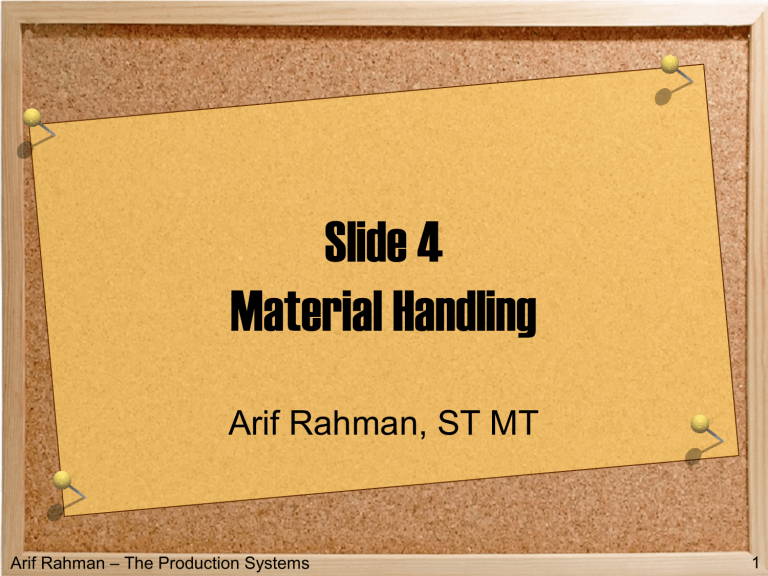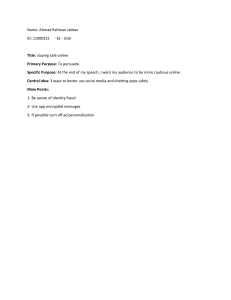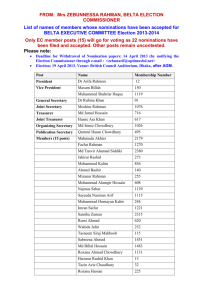
Slide 4 Material Handling Arif Rahman, ST MT Arif Rahman – The Production Systems 1 Storage System Performance And Location Strategies Arif Rahman – The Production Systems 2 Storage Systems Function – to store materials (e.g., parts, work-in-process, finished goods) for a period of time and permit retrieval when required Used in factories, warehouses, distribution centres, wholesale dealerships, and retail stores Important supply chain component Automation available to improve efficiency Arif Rahman – The Production Systems 3 Types of Materials Typically Stored in Factory Type Description Raw materials Raw stock to be processed (e.g., bar stock, sheet metal, plastic moulding compound) Purchased parts Parts from vendors to be processed or assembled (e.g., castings, purchased components) Work-inprocess Partially completed parts between processing operations or parts awaiting assembly Finished product Completed product ready for shipment Rework and scrap Parts that are out of specification, either to be reworked or scrapped Arif Rahman – The Production Systems 4 Types of Materials Typically Stored in Factory Type Description Refuse Chips, swarf, oils, other waste products left over after processing; these materials must be disposed of, sometimes using special precautions Tooling Cutting tools, jigs, fixtures, molds, dies, welding wire, and other tooling used in manufacturing and assembly; supplies such as helmets, gloves, etc., are usually included Spare parts Parts are needed for maintenance and repair of factory equipment Arif Rahman – The Production Systems 5 Types of Materials Typically Stored in Factory Type Description Office supplies Paper, paper forms, writing instruments, and other items used in support of plant office Plant records Records on product, equipment, and personnel Arif Rahman – The Production Systems 6 Storage System Performance: Measures Storage capacity - two measures: ¤ Total volumetric space ¤ Total number of storage compartments (e.g., unit loads) Storage density - volumetric space available for storage relative to total volumetric space in facility Accessibility - capability to access any item in storage System throughput - hourly rate of storage/retrieval transactions Utilization - the proportion of time that the system is actually being used for performing storage and retrieval operations compared with the time it is available Availability (reliability) – the proportion of time that the system is capable of operating (not broken down) compared with the normally scheduled shift hours Arif Rahman – The Production Systems 7 Storage System Performance: System Throughput System throughput is limited by the time to perform a S/R transaction Elements of storage transaction: ¤ ¤ ¤ ¤ Pick up load at input station Travel to storage location Place load into storage location Travel back to input station Elements of retrieval transaction: ¤ ¤ ¤ ¤ Travel to storage location Pick item from storage Travel to output station Unload at output station Arif Rahman – The Production Systems 8 Storage System Performance: System Throughput The sum of the element times is the transaction time that determines throughput of the storage system Throughput can sometimes be increased by combining storage and retrieval transactions in one cycle, thus reducing travel time; this is called a dual command cycle When either a storage and a retrieval transaction alone is performed in the cycle, it is called a single command cycle Arif Rahman – The Production Systems 9 Storage Location Strategies Randomized storage – ¤ Incoming items are stored in any available location ¤ Usually means nearest available open location Dedicated storage – ¤ Incoming items are assigned to specific locations in the storage facility Arif Rahman – The Production Systems 10 Storage Location Strategies Typical bases for deciding locations: ¤ Items stored in item number sequence ¤ Items stored according to activity level ¤ Items stored according to activity-to-space ratios Arif Rahman – The Production Systems 11 Comparison of Storage Strategies Less total space is required in a storage system that uses a randomized storage strategy ¤ Dedicated storage requires space for maximum inventory level of each item Higher throughput rates are achieved in a system that uses dedicated storage strategy based on activity level ¤ The most active items can be located near the input/output point ¤ Compromise: Class-based dedicated storage • Items divided into classes according to activity level • Random storage strategy used within each class Arif Rahman – The Production Systems 12 Types of Storage Equipment and Methods Storage type Advantage/ Disadvantage Typical application Bulk storage •Highest density is possible •Low accessibility •Low possible cost/square foot •Storage of low turnover, large stock or large unit load Rack systems •Low cost •Palletized loads in •Good storage warehouses density •Good accessibility Arif Rahman – The Production Systems 13 Types of Storage Equipment and Methods Storage type Advantage/ Disadvantage Typical application Shelves and bins •Some stock items •Storage of not clearly visible individual, commodity items in shelve/bins Drawer storage •Contents of •Small tools •Small stock items drawer easily visible •Repair part •Good accessibility •Relatively high cost Arif Rahman – The Production Systems 14 Types of Storage Equipment and Methods Storage type Advantage/ Disadvantage Automated storage systems •High throughput rates •Computerized inventory control system •Highest cost equipment •Automated material handling systems Arif Rahman – The Production Systems Typical application •Work in progress storage •Final product warehousing and distribution center •Order picking 15 Conventional storage methods and equipment Bulk storage - storage in an open floor area ¤ Problem: achieving proper balance between storage density and accessibility Rack systems - structure with racks for pallet loads ¤ Permits vertical stacking of materials Shelving and bins - horizontal platforms in structural frame ¤ Steel shelving comes in standard sizes ¤ Finding items can be a problem Drawer storage - entire contents of each drawer can be viewed Arif Rahman – The Production Systems 16 Bulk Storage Bulk storage arrangements: (a)high-density bulk storage provides low accessibility, (b)bulk storage with loads forming rows and blocks for improved accessibility Arif Rahman – The Production Systems 17 Arrangements Arif Rahman – The Production Systems 18 Bulk Storage Arif Rahman – The Production Systems 19 Pallet Rack System Pallet loads placed on racks in multi-rack structure (a)Low cost (b)Good storage density (c) Good accessibility Arif Rahman – The Production Systems 20 Other Rack System Cantilever racks Portable racks Drive-through racks Flow-through racks Arif Rahman – The Production Systems 21 Cantilever Rack System Arif Rahman – The Production Systems 22 Drive-trough Rack System Arif Rahman – The Production Systems 23 Flow-trough Rack System Arif Rahman – The Production Systems 24 Sliding Rack System Arif Rahman – The Production Systems 25 Shelves and Bins Some stock item not clearly invisible Storage of individual in shelves or bins Arif Rahman – The Production Systems 26 Drawer Storage Contents easily visible Good accessibility Relatively high cost Small items (tools, repair parts, etc.) Arif Rahman – The Production Systems 27 Automated storage system Arif Rahman – The Production Systems 28 Automated storage system Mechanized and automated storage equipment to reduce the human resources required to operate a storage facility Significant investment Level of automation varies ¤ In mechanized systems, an operator participates in each storage/retrieval transaction ¤ In highly automated systems, loads are entered or retrieved under computer control Arif Rahman – The Production Systems 29 Objectives of Automating Storage Operations To increase storage capacity To increase storage density To recover factory floor space currently used for WIP To improve security and reduce pilferage To reduce labor cost and/or increase productivity To improve safety To improve inventory control To improve stock rotation To improve customer service To increase throughput Arif Rahman – The Production Systems 30 Types of Automated Storage System Automated Storage/Retrieval System (AS/RS) ¤ Rack system with mechanized or automated crane to store/retrieve loads Carousel Storage System ¤ Oval conveyor system with bins to contain individual items Arif Rahman – The Production Systems 31 Differences between an AS/RS and a Carousel Storage System Feature Basic AS/RS Basic Carousel Storage System Storage Structure Rack system to support pallets or shelf system to support tote bins Baskets suspended from overhead conveyor trolleys Motions Linear motions of S/R machine Revolution of overhead conveyor trolleys around oval track Storage/Retrieva S/R machine travels to l Operation compartments in rack structure Conveyor revolves to bring baskets to load/unload station Replication of Storage Capacity Multiple carousels, each consisting of oval track and suspended bins Multiple aisles, each consisting of rack structure and S/R machine Arif Rahman – The Production Systems 32 Automated Storage/Retrieval System Arif Rahman – The Production Systems 33 Carousel Storage System Arif Rahman – The Production Systems 34 Automated Storage/Retrieval System (AS/RS) Arif Rahman – The Production Systems 35 Automated Storage/Retrieval System Arif Rahman – The Production Systems 36 Automated Storage/Retrieval System Arif Rahman – The Production Systems 37 AS/RS Unit load on pallet AS/RS with one aisle Arif Rahman – The Production Systems 38 AS/RS Types Unit load AS/RS - large automated system for pallet loads Deep-lane AS/RS - uses flow-through racks and fewer access aisles Miniload AS/RS - handles small loads contained in bins or drawers to perform order picking Man-on-board AS/RS - human operator rides on the carriage to pick individual items from storage Automated item retrieval system - picks individual items Vertical lift storage modules (VLSM) - uses a vertical aisle rather than a horizontal aisle as in other AS/RS types Arif Rahman – The Production Systems 39 Unit load AS/RS Arif Rahman – The Production Systems 40 Deep-lane AS/RS Arif Rahman – The Production Systems 41 Miniload AS/RS Arif Rahman – The Production Systems 42 Man-on-board AS/RS Arif Rahman – The Production Systems 43 Automated item retrieval system Arif Rahman – The Production Systems 44 AS/RS Applications Unit load storage and retrieval ¤ Warehousing and distribution operations ¤ AS/RS types: unit load, deep lane (food industry) Order picking ¤ AS/RS types: miniload, man-on-board, item retrieval Work-in-process storage ¤ Helps to manage WIP in factory operations ¤ Buffer storage between operations with different production rates ¤ Supports JIT manufacturing strategy ¤ Kitting of parts for assembly Arif Rahman – The Production Systems 45 AS/RS Automated storage systems help to regain control over WIP Reasons that justify the installation of automated storage systems for WIP include ¤ ¤ ¤ ¤ ¤ Buffer storage in production Support of just-in-time delivery Kitting of parts for assembly Compatible with automatic identification systems Support of factory-wide automation Arif Rahman – The Production Systems 46 Components and Operating Features of an AS/RS Storage structure S/R machine Storage modules (e.g., pallets for unit loads) One or more pickup-and-deposit stations A control system that required to operate the AS/RS Arif Rahman – The Production Systems 47 Sizing the AS/RS Rack Structure ny = number of load compartments along the length of the aisle nz = number of load compartments that make up the height of the aisle Capacity of the aisle = 2 Arif Rahman – The Production Systems ny nz 48 Sizing the AS/RS Rack Structure x = the depth dimensions of a unit load y = the width dimensions of a unit load z = the height of the unit load W = the width of one aisle of the AS/RS rack structure L = the length of one aisle of the AS/RS rack structure H = the height of one aisle of the AS/RS rack structure a, b, c = allowances designed into each storage compartment to provide clearance for the unit load and to account for the size of the supporting beams in the rack structure Arif Rahman – The Production Systems 49 Sizing the AS/RS Rack Structure W = 3 (x + a) L = ny (y + b) H = nz (z + c) Arif Rahman – The Production Systems 50 AS/RS Throughput Assumes: ¤ Randomized storage of loads n the AS/RS (i.e., any compartment in the storage aisle is equally likely to be selected for a transaction) ¤ Storage compartments are of equal size ¤ The P & D (pickup-and-deposit) station is located at the base and end of the aisle ¤ Constant horizontal and vertical speeds of the S/R machine ¤ Simultaneous horizontal and vertical travel Arif Rahman – The Production Systems 51 AS/RS Throughput: Single Command Cycle Tcs = cycle time of a single command cycle (min/cycle) L = length of the AS/RS rack structure (m) vy = velocity of the S/R machine along the length of the AS/RS (m/min) H = height of the rack structure (m) vz = velocity of the S/R machine in the vertical direction of the AS/RS (m/min) Tpd = pickup-and-deposit time (min) Arif Rahman – The Production Systems 52 AS/RS Throughput: Single Command Cycle 0.5 L 0.5 H Tcs = 2 Max , + 2Tpd v z v y L H = Max , + 2Tpd v y v z Arif Rahman – The Production Systems 53 AS/RS Throughput: Dual Command Cycle The S/R machine is assumed to travel to the centre of the rack structure to deposit a load, and then it travels to ¾ the length and height of the AS/RS to retrieve a load Arif Rahman – The Production Systems 54 AS/RS Throughput: Dual Command Cycle 0.75 L 0.75 H Tcd = 2 Max , + 4T pd v z v y 1.5 L 1.5 H = Max , + 4T pd v z v y Arif Rahman – The Production Systems 55 AS/RS Throughput Rcs = number of single command cycles performed per hour Rcd = number of dual command cycles per hour at a specified or assumed utilization level U = system utilization Rc = total S/R cycle rate (cycles/hr) Rt = the total number of transactions performed per hour Arif Rahman – The Production Systems 56 AS/RS Throughput The amount of time spent in performing single command and dual command cycles per hour Rcs Tcs + Rcd Tcd = 60 U The total hourly cycle rate Rc = Rcs + Rcd The total number of transactions Rt = Rcs + 2Rcd Arif Rahman – The Production Systems 57 Example Each aisle of a five-aisle Automated Storage/Retrieval System is to contain 40 storage compartments in the length direction and eight compartments in the vertical direction. All storage compartments will be the same size to accommodate standard size pallets of dimension: x = 30 in and y = 40 in. The height of a unit load z = 25 in. Using the allowances a = 6 in, b = 8 in, and c = 10 in, determine: ¤ How many unit loads can be stored in the AS/RS ¤ The width, length, and height of the AS/RS Consider that an S/R machine is used for each aisle. Suppose horizontal and vertical speeds of the S/R machine are 250 ft/min and 50 ft/min, respectively. The S/R machine requires 18 sec to accomplish a pick-and-deposit operation. Find: ¤ The single command and dual command cycle times per aisle ¤ Throughput for the aisle under the assumptions that storage system utilization = 90% and the numbers of single command and dual command cycles are equal. Arif Rahman – The Production Systems 58 Carousel Storage System Arif Rahman – The Production Systems 59 Carousel Storage Systems Horizontal ¤ Operation is similar to overhead conveyor system used in dry cleaning establishments ¤ Items are stored in bins suspended from the conveyor ¤ Lengths range between 3 m and 30 m ¤ Horizontal is most common type Vertical ¤ Operates around a vertical conveyor loop ¤ Less floor space required, but overhead room must be provided Arif Rahman – The Production Systems 60 Carousel Storage Systems Arif Rahman – The Production Systems 61 Carousel Storage Systems Arif Rahman – The Production Systems 62 Horizontal Carousel Storage System Manually operated horizontal carousel storage system Arif Rahman – The Production Systems 63 Horizontal Carousel Storage Systems Arif Rahman – The Production Systems 64 Vertical Carousel Storage Systems Vertical Carousels consist of a series of horizontal trays on a vertical carousel. Vertical carousels are most effective when floor space is at a minimum and there is ample overhead clearance. Arif Rahman – The Production Systems 65 Vertical Carousel Storage Systems Arif Rahman – The Production Systems 66 Carousel Applications Storage and retrieval operations ¤ Order picking ¤ Kitting of parts for assembly Transport and accumulation ¤ Progressive assembly with assembly stations located around carousel Work-in-process ¤ WIP applications in electronics industry are common Unique applications ¤ Example: time testing of electrical products Arif Rahman – The Production Systems 67 Storage Capacity C = circumference of oval conveyor track L = the length of the track oval W = the width of the track oval nb = the number of bins hanging vertically from each carrier nc = the number of carriers around the periphery of the rail sc = the center-to-center spacing of carriers along the oval track/carrier spacing (m/carrier) Arif Rahman – The Production Systems 68 Storage Capacity C = 2 (L – W) + π W Total number of bins = nc nb sc n c = C Arif Rahman – The Production Systems 69 Throughput Analysis Assumptions ¤ Only single command cycles are performed: a bin is accessed in the carousel either to put items into storage or to retrieve one or more items from storage ¤ The carousel operates with a constant speed vc: acceleration and deceleration effects are ignored ¤ Random storage is assumed: that is, any location around the carousel is equally likely to be selected for an S/R transaction ¤ The carousel can move in either direction Arif Rahman – The Production Systems 70 Throughput Analysis Tc = S/R cycle time (min) C = carousel circumference (m) vc = carousel velocity (m/min) Tpd = the average time required to pick or deposit items each cycle by the operator at the load/unload station (min) ¤ The number of transactions accomplished per hour is the same as the number of cycles Arif Rahman – The Production Systems 71 Throughput Analysis C Tc = + T pd 4vc 60U Rt = Rc = Tc Arif Rahman – The Production Systems 72 Example Suatu sistem penyimpanan carousel tunggal memiliki suatu rel loop oval dengan ukuran panjang 40 kaki dan lebar 3 kaki. Delapan kereta pembawa terpasang dengan jarak sama sepanjang rel oval. Ada 6 kotak tergantung pada masing-masing pembawa. Setiap kotak berkapasitas volumetric 1.25 m2. Kecepatan carousel = 80 kaki/menit. Waktu ambil/simpan rata-rata = 25 detik. Tentukan: ¤ Kapasitas volumetric sistem penyimpanan ini ¤ Laju pengambilan sistem penyimpanan per jam Arif Rahman – The Production Systems 73 AUTOMATED DATA CAPTURE Arif Rahman – The Production Systems 74 Automated Data Capture Also known as automatic identification and data capture (AIDC) It refers to the technologies that provide direct entry of data into a computer or other microprocessor controlled system without using a keyboard. These technologies require no human involvement in the data capture and entry process. Arif Rahman – The Production Systems 75 Automated Data Capture Collect data in material handling and manufacturing applications. ¤ In material handling, the applications include shipping and receiving, storage, sortation, order picking. and kitting of parts for assembly. ¤ In manufacturing, the applications include monitoring the status of order processing, work-in-process, machine utilization, worker attendance, and other measures of factory operations and performance. ADC has many important applications outside the factory; including retail sales and inventory control. warehousing and distribution center operations, mail and parcel handling, patient identification in hospitals, check processing in banks, and security systems. Arif Rahman – The Production Systems 76 Automatic Identification Technologies The automatic identification technologies consist of three principal components, Encoded. A code is a set of symbols or signals (usually) representing alphanumeric characters. When data are encoded, the characters are translated into a machine-readable code. Machine reader or scanner. This device reads the encoded data, converting them to alternative form, usually an electrical analog signal. Decoder. This component transforms the electrical signal into digital data and finally back into the original alphanumeric characters. Arif Rahman – The Production Systems 77 ADC Technologies Categories ADC technologies can be divided into the following six categories : ¤ Optical ¤ Magnetic ¤ Electromagnetic ¤ Smart Card ¤ Touch Techniques ¤ Biometric Arif Rahman – The Production Systems 78 ADC Technologies most widely used 1. 2. 3. 4. 5. bar codes radio frequency methods, magnetic stripe, optical character recognition, and machine vision, Arif Rahman – The Production Systems 79 ADC Technologies Arif Rahman – The Production Systems 80 Barcode Technology Readable code The symbol consists of bars and spaces of varying width or height; Two basic types: ¤ Linear (one-dimensional), in which the encoded data are read using a linear sweep of the scanner, ¤ Two-dimensional, in which the encoded data must be read in both directions.Bar code scanner/reader Bar code readers and printers Arif Rahman – The Production Systems 81 Barcode Technology Arif Rahman – The Production Systems 82 Barcode Technology Advantages: ¤ Data entry is faster, ¤ Data input is more accurate, ¤ Data search is more integrity, ¤ Reduce Costs, ¤ Management Performance Improvement Arif Rahman – The Production Systems 83 Barcode Technology Arif Rahman – The Production Systems 84 Barcode Technology: LINEAR BARCODE (1 D) Arif Rahman – The Production Systems 85 Barcode Technology: LINEAR BARCODE (1 D) Universal product code ¤ A numeric barcode ¤ Has a fixed length about 12 digits. Six digits to identify the manufacturer, five digits to identify the product, and the final digit is a check character. ¤ UPC is used for retail product labelling. ¤ This symbol is made to ease of authenticity of a product. UPC numbers must be registered or registered with the Uniform Code Council. Arif Rahman – The Production Systems 86 Barcode Technology: LINEAR BARCODE (1 D) Code 39 ¤ An alphanumeric barcode (full ASCII). ¤ Has a varied length. ¤ Code 39 is used for product identification, inventory control, and automation of the check-out procedure. And also for asset tracking and identity recognition. Arif Rahman – The Production Systems 87 Barcode Technology: LINEAR BARCODE (1 D) Code 128 ¤ An alphanumeric barcode (full ASCII). ¤ Has a varied length with high density. ¤ Code 128 is used for shipping and warehouse management. Arif Rahman – The Production Systems 88 Barcode Technology: LINEAR BARCODE (1 D) Arif Rahman – The Production Systems 89 Barcode Technology: Two-dimensional Advantage: ¤ Has higher capacity to store much greater amounts of data at higher area densities. It has better speed, accuracy of data and the number of characters that can be accommodated. With capacity up to 2000 characters, 2D Barcode is enough to encode some text and compressed image files. ¤ 2D Barcode can be printed in smaller space. • Stacked Bar Codes • Matrix Symbologies. ¤ A digital camera and an application can be implemented as devices to scan and read 2D Barcode Arif Rahman – The Production Systems 90 Barcode Technology: Two-dimensional Arif Rahman – The Production Systems 91 Barcode Technology: Two-dimensional Arif Rahman – The Production Systems 92 Barcode Technology BARCODE SCANNER / READERS ¤ Barcode reader/scanner adalah perangkat untuk membaca kode-kode garis visual barcode. Hanya dengan menyapukan segaris sinar laser, ia dengan cepat membaca fragmen terang gelap pada barcode yang tercetak di kertas dengan sangat cepat dan akurat. Pada perkembangan selanjutnya, sinar laser yang dipancarkan tidak hanya sebentuk garis saja tapi berupa kombinasi pola yang rumit sehingga mampu membaca barcode dari sudut manapun. Arif Rahman – The Production Systems 93 Barcode Technology BARCODE PRINTERS ¤ Simbol barcode bisa dihasilkan dengan beragam cara mulai penandaan langsung (direct marking) atau mencetak dengan ink jet atau mencetak simbol barcode kedalam label terpisah (separate label). Printer barcode adalah sebuah peralatan komputer yang digunakan untuk mencetak label barcode maupun kartu penanda (tag). Sekali label barcode dicetak maka akan dapat ditempel pada obyek fisik seperti barang-barang retail dan perkapalan. Arif Rahman – The Production Systems 94 Other ADC Technologies Radio frequency identification Magnetic stripes Optical character recognition Machine vision Arif Rahman – The Production Systems 95 Radio frequency identification metode identifikasi dengan menggunakan sarana yang disebut label RFID atau transponder untuk menyimpan dan mengambil data jarak jauh Arif Rahman – The Production Systems 96 Radio frequency identification terdiri dari dua bagian: ¤ RFID reader • Membaca kode-kode pada tag ¤ RFID tag atau label • sebuah benda yang bisa dipasang atau dimasukkan di dalam sebuah produk, hewan atau bahkan manusia dengan tujuan untuk identifikasi menggunakan gelombang radio Arif Rahman – The Production Systems 97 Radio frequency identification Arif Rahman – The Production Systems 98 Arif Rahman – The Production Systems 99 Magnetic stripes Dilampirkan pada produk yang biasanya digunakan untuk mengidentifikasi dalam aplikasi gudang dan persediaan Film plastik yang tipis yang mengandung partikel magnetic kecil yang dapat digunakan untuk mengkode data menjadi bentuk film. Pita warna hitam Dapat dibaca ataupun ditulis (R/W) Arif Rahman – The Production Systems 100 Magnetic stripes Arif Rahman – The Production Systems 101 Optical Character Recognition Sistem komputer yang dapat membaca huruf, baik yang berasal dari pencetak maupun tulisan tangan Metoda pembacaan data oleh scanner optik dan menterjemahkan data tersebut ke dalam bentuk data biner yang dapat dibaca oleh komputer. Mengubah hard copy menjadi softcopy Pencocokan pola Dua metode: ¤ Matric matching (pencocokan pola karakter dengan data base) ¤ Feture Extruction (mendeteksi karakter dari ruang kosong, garis diagonal, bentuk yang berpotongan, dan perpotogan garis) Memudahkan penyortiran surat di kantor pos, pemasukan data di perpustakaan, mendeteksi tanda tangan, sidik jari scaner Pola gambar kode huruf-huruf berupa angka Arif Rahman – The Production Systems 102 Optical Character Recognition Arif Rahman – The Production Systems 103 Optical Character Recognition Data capture merupakan proses konversi suatu dokumen (hardcopy) menjadi suatu file gambar (BMP). Preprocessing merupakan suatu proses untuk menghilangkan bagian-bagian yang tidak diperlukan pada gambar input untuk proses selanjutnya. contoh preprocessing adalah noise filtering. Segmentasi adalah proses memisahkan area pengamatan (region) pada tiap karakter yg akan dideteksi. Normalization adalah proses merubah dimensi region tiap karakter dan ketebalan karakter. Dalam OCR algoritma yang digunakan pada proses ini adalah algoritma scaling dan thinning. Feature Extraction adalah proses untuk mengambil ciri-ciri tertentu dari karakter yang diamati. Recognition merupakan proses untuk mengenali karakter yang diamati dengan cara membandingkan ciri-ciri karakter yang diperoleh dengan ciri-ciri karakter yang ada pada database. Postprocessing pada umumnya adalah proses yang dilakukan pada tahap ini adalah proses koreksi ejaan sesuai dengan bahasa yang digunakan. Arif Rahman – The Production Systems 104 Optical Character Recognition Arif Rahman – The Production Systems 105 Machine Vision Definisi ¤ Sensing of vision data and its interpretation by a computer Terdiri atas ¤ Camera and digitizing hardware ¤ Digital computer ¤ Hardware and software necessary to interface them (preprocessor) Arif Rahman – The Production Systems 106 Machine Vision Fungsi di dalam Operasi MV ¤ Terdiri daripada 3 fungsi dalam machine vision • Fungsi I: Sensing and digitizing image data • Fungsi II: Image processing and analysis • Fungsi III: Application ¤ Setiap fungsi mempunyai kepentingan masing-masing dalam satu sistem machine vision Arif Rahman – The Production Systems 107 Machine Vision Arif Rahman – The Production Systems 108 Machine Vision Pengenalan Fungsi I ¤ Sensing and digitizing image data • Hardware Camera Lighting Frame Grabber • Teknik dan Aplikasi Signal conversion Image Storage/Frame grabber Lighting ¤ Memerlukan teknik pencahayaan (lighting) yg istimewa ¤ Frames mengandungi pictures elements/ pixels ¤ Image bagi setiap frame disimpan dan dibawa ke Fungsi ke II Arif Rahman – The Production Systems 109 Machine Vision Pengenalan Fungsi II ¤ Image Processing and Analysis • Hardware Computer (processor) Monitor/keyboard Stored programs/algorithm • Teknik dan Aplikasi Data reduction Segmentation Object recognition ¤ fungsi II, sistem machine vision harus dilatih Arif Rahman – The Production Systems 110 Machine Vision Pengenalan Fungsi III ¤ Application • Hardware Robot controller • Teknik dan Aplikasi Inspection Identification Visual navigation Arif Rahman – The Production Systems 111 Perbandingan teknik ADC Techniqu e Time to Enter Error Rate Equipment Advantage/ Cost (disadvantages) Manual Entry Slow High Low Low initial cost Requires human operator (slow speed) (High error rate) Bar code : 1D Mediu m Low Low High speed Good flexibility (low data density) Bar code : 2D Mediu m Low High High speed High data density (high equipment cost) Low High Label need not be visible (expensive labeling) Radio Fast Frequency Arif Rahman – The Production Systems 112 Perbandingan teknik ADC Techniqu e Time to Enter Error Rate Equipment Advantage/ Cost (disadvantages) Magnetic Stripe Mediu m Low Medium Much data can be encode Data can be changed (vulnerable to magnetic field) (Contact required to reading) OCR Mediu m Mediu m Medium Can be read by humans (low data density) (high error rate) *** Very high Equipment expensive (not suited to general) ADC Machine Fast Vision Application Arif Rahman – The Production Systems 113 It’s end of slides… … Any question ? Arif Rahman – The Production Systems 114



